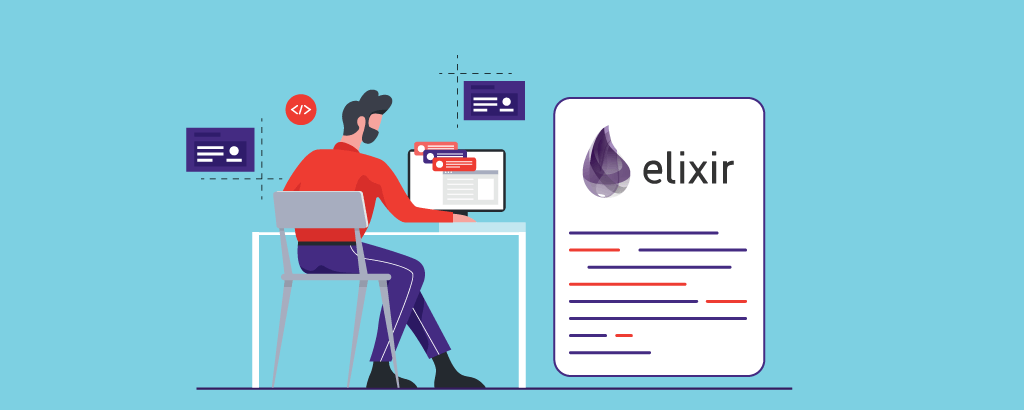The Promising Horizon: Examining Elixir as Web App Development’s Future
Are the programming languages used for web development really competent enough? Or is it high time to change the approach and fit in new ones to the programming repertoire of web development? If the second one is your choice, then you can push behind the commonly used Ruby, PHP and Python to welcome Elixir programming! No, not the magical potion in the real sense of the word, but with a power to cure web apps of its lagging performance through high-quality code.
If Elixir is as exciting as it sounds, there’s no wonder that the existence of other programming languages has been called to question. So, we’ll do some reality check if this emerging star, the Elixir framework, is here to stay?
Elixir and Beyond
Elixir language made its first entry into the development environment in the year 2012. It was the brainchild of Jose Valim, a Brazilian developer who wanted to overcome the limitations of Ruby programming language.  Although Ruby is smart with generators and templates to formulate the outline of a project, when it came to working under high load Ruby failed miserably. So, Valim chose a productive coding language such as Erlang. Therefore, Elixir for software development was built on top of the bytecode seen on the Erlang Virtual Machine called BEAM. This has been very significant in the progression of Elixir despite being a young programming language.
Although Ruby is smart with generators and templates to formulate the outline of a project, when it came to working under high load Ruby failed miserably. So, Valim chose a productive coding language such as Erlang. Therefore, Elixir for software development was built on top of the bytecode seen on the Erlang Virtual Machine called BEAM. This has been very significant in the progression of Elixir despite being a young programming language.
Now, unlike Ruby, Elixir programming was capable of handling huge spikes with billions of users going online at the same time. It is interesting to note that a group of six called the Elixir Core team is responsible for the source code. They are namely, Jose Valim, James Fish, Fernando Tapia Rico, Eric Meadows-Jonsson, Aleksei Magusev and Andrea Leopardi. The team resorts to a change in the code base with a shared agreement of all six. Again, Elixir also has a thriving community that contributes to its steadfast growth.
Community members are always welcomed by the Core team for new proposals which have to first go through an Elixir mailing list before it is approved for inclusion. That said, Elixir has become a popular backend choice, but do you know that Elixir can also produce front-end apps with the help of Phoenix framework? Just as Rails is for Ruby. Now, you cannot deny the fact that it is going to be around for quite a long time as Elixir full stack solution.
6 Startling Features of Elixir Functional Programming
Elixir is a master of functional programming which is opposed to the object oriented model adopted by Ruby. So, what is Elixir? It is that Functional web development with Elixir makes your codes short, fast and maintainable. Since functional programming is a type of paradigm, its major feature is the ability to avoid side effects while calling a method. Your software will run as expected with Elixi’s capacity of pattern matching, immutable data and first class functions. We are not just doing away with this, let’s look at the other 6 standout features that Elixir has under its hood!
Immutable Data
Elixir being a functional programming language has to do a lot with data immutability. It simply means that once the data is declared, it cannot be subjected to any kind of changes/mutated. The peculiarity of this feature is that when the variables are passed around in a program, they cannot be altered. In case you try to add an element into an Elixir list it will only generate a new list with the added element. As a result data consistency is maintained as states are not changing constantly and it also becomes easier to catch bugs.
Concurrency Model
Elixir features a concurrency model which is opposed to the parallel model in other systems. Concurrency guarantees that two separate pieces of code are executed at different times in different contexts. There are some lightweight threads which are isolated and communicate through messages to each other. On the other hand, parallelism happens when the two segments of code are executed at the same time. The concurrency feature allows Elixir to function seamlessly on extreme load without any hindrance.
Conciseness
Functional web development with elixir makes small functions with a clarity of purpose. It’s not haphazard, as you can clearly make out the data that is passed through a function and what is received at the other end. A major advantage of functions being concise is that is easily testable and basic changes can be made quickly.
Quicker Refactoring
Refactoring in coding is known as the process of cleaning up the already written code without interrupting the existing function of it. Code refactoring is a useful step in getting rid of “code rot” and avoiding the headache of costly errors at a later point. But it can sometimes lead to breakages where intensive care is not taken. But not with the Elixir programming language! It’s code immutability allows for easier and stressless refactoring.
Fault Tolerance
Fault tolerance in Elixir and Erlang is commonly associated with the phrase “Let it Crash”. But that’s counter intuitive isn’t it? But there is a reason for not doing any defensive programming when a bug occurs. Because unlike other languages where an error can cause the whole app to crash, fault tolerance in Elixir language will recover from the error by restarting only the affected parts. Failure is contained to a single process while the rest of the system keeps running smoothly.
Process Based Nature
Elixir programming language is unlike other languages in its ability to rewrite codes when the service starts to scale. It only calls for a few changes at certain places instead of working over the entire code again. This is attributed to Elixir’s ability to parallelize workloads efficiently. Which is again credited to its functioning on Erlang. Again with Phoenix, Elixir is able to carry out multiple processes with mow memory footprint having a lesser severity on performance. That brings us to our next topic of interest. Phoenix web framework!
Phoenix : Elixir for Frontend in Action
As we saw earlier, the advent of Phoenix expanded the applicability Elixir across the modern web development sphere.  As a server-side web framework written in Elixir used for Elixir programming, it also has a top-notch development attitude using Erlang VM. Again when this is teamed up with the Elixir’s functional proficiency, Phoenix rises with dynamic web apps that match market trends. It was built with an MVC pattern in mind and is also supported by BEAM.
As a server-side web framework written in Elixir used for Elixir programming, it also has a top-notch development attitude using Erlang VM. Again when this is teamed up with the Elixir’s functional proficiency, Phoenix rises with dynamic web apps that match market trends. It was built with an MVC pattern in mind and is also supported by BEAM.
Phoenix was highly inspired by Ruby’s use of Rails to take web development par excellence. But there comes a downside, the Elixir-Phoenix ecosystem is not as strong or mature as Ruby on Rails or Python-Django. This is simply because Phoenix is yet to hit the list of popularity.
But talking of a bigger picture, it’s definitely worth a try because the benefits outweigh the drawbacks. Say for instance, while developers complain Ruby is slow, Phoenix scores a point for serving tonnes of users with excellent fault tolerance. Should that even be pointed out? For all obvious reasons, Phoenix is the offspring of Elixir and Erlang and will definitely receive all of its benefits including simplicity, speed, scalability, reliability, maintainability and productivity.
Companies powered by Elixir
Developers cannot resist working with the Elixir framework, and it seems like companies who wish to scale have also chosen Elixir as their core technology. Look at who has cast Elixir in their production!
- PepsiCo: The world’s second-largest food and beverages company is backed by Elixir development for their marketing automation and supply chain optimization processes.
- Moz: This renown SEO analytics company set up a database-free architecture with the help of the Elixir data indexing model.
- Whatsapp, WeChat and Facebook: These messaging applications were supported by Erlang to handle their humongous user base
- Pinterest: More than 30k events are routed per second into the app’s rule engine to prevent spam using Elixir. The app also reports a tenfold drop in the codebase size. Thanks to Elixir backing its notification system
Pattem Digital can be your smart Elixir development partner!
Looking to make the Elixir framework as a robust base for a growing business? Pattem Digital as an Elixir development company provides best services that have risen from the field experience of developing extremely performant and fault tolerant Elixir apps. Our engineers develop mastery of Elixir features and make smart recommendations in the best interest of our client’s values. Get in touch with us if you are looking for a product development company that meets your targets!





